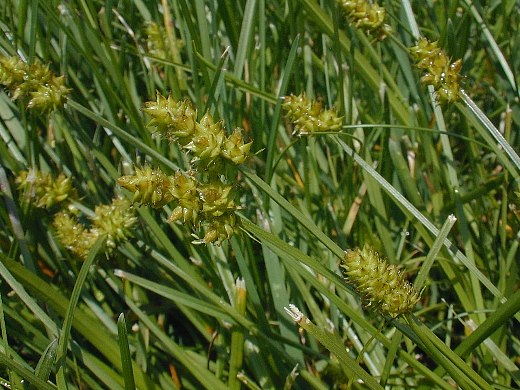Description: This perennial sedge is about 1-2' tall. It usually forms tufts of multiple culms and leaves spanning about 1–1½' across. The culms are erect, ascending, or widely spreading; they are unbranched, triangular, and hairless. Each culm has rough edges underneath the inflorescence, otherwise it is smooth. There are about 3 alternate leaves along the lower third of each culm. The leaf blades are up to 8" long and 5 mm. across; they are medium green, hairless, and ascending, widely spreading, or drooping. The leaf sheaths are whitish green, hairless, and concave at the apex; the lower sheaths are occasionally loose. In some habitats (e.g., mowed lawns), this sedge will have smaller leaf blades (about 4" long & 3 mm. across) and shorter culms (up to 1' long).

Each culm
terminates in an inflorescence about 1.5 cm. long and 1.0 cm. across;
this inflorescence consists of 5-8 sessile spikelets that are tightly
clustered together. At the base of this cluster of spikelets, there is
usually a linear bract up to 1.5 cm. long. Each spikelet is about 5 mm.
long and 5 mm. across; it consists of a tight cluster of ascending to
widely spreading perigynia, floral scales, and their florets. The male
(staminate) florets are located toward the apex of each spikelet, while
the female (pistillate) florets are located along the remainder of the
spikelet. The perigynia of the female florets are up to 3 mm. long, 2
mm. across, glabrous, and flattened (more specifically, plano-convex).
Each perigynium is ovate-cordate with a short slender beak; its base is
well-rounded to slightly wedge-shaped. The upper half of each immature
perigynium is green, while the lower half is greenish white; mature
perigynia become yellowish brown. The pistillate scale of each
perigynium is up to 2 mm. long and 1 mm. across toward the base; it has
a long slender tip at the apex. Immature pistillate scales have green
central veins and membranous margins; they later become light
yellowish-brown. The blooming period occurs from mid-spring to early
summer. The female florets are wind-pollinated. Each perigynium
contains a small flattened achene that is oval-shaped, often with a
tiny bump on the bottom. The root system is fibrous and
short-rhizomatous.

Cultivation:
This sedge is typically found in partial to full sun and more or less
mesic conditions. It tolerates soil containing loam, clay-loam, rocky
material, or sand. This is one of the few sedges that can invade lawns.
Range & Habitat:
The native Capitate Sedge is common throughout Illinois (see Distribution
Map). Habitats include thin upland woodlands and savannas,
rocky wooded slopes, woodland borders (particularly where there is
occasional mowing), sandy or rocky meadows in wooded areas, grassy
roadsides, abandoned fields, pastures, vacant lots, and lawns. This
sedge is particularly common in disturbed habitats.
Faunal Associations:
The caterpillars of several butterflies, skippers, and moths feed on
sedges (Carex spp.); the Lepidoptera
Table lists many of these species. Several species of
leafhoppers (particularly Cosmotettix spp.) suck
juices from the foliage. The seeds of sedges are an important source of
food to many birds (see the Bird Table); because Capitate Sedge
is not a wetland species, its value as a food plant is restricted
primarily to upland gamebirds and granivorous songbirds (e.g.,
sparrows). Hoofed mammalian herbivores may graze on sedges
occasionally, but it is not preferred as a source of food. Capitate
Sedge is too low-growing to provide much cover for wildlife.
Photographic Location:
The lawn of the webmaster's apartment complex in Urbana, Illinois.
Comments:
Because of its early growth, Capitate Sedge is more conspicuous during
the spring. At this time, its fertile culms will form short dense heads
of spikelets, unless they become decapitated by a lawn mower or a cow.
A second attempt to bloom will occur during the early summer if the
first attempt fails. Because this sedge is similar in appearance to
several others, it can be difficult to identify. It is more likely to
be found in lawns and other mowed areas than these other sedges,
however. Capitate Sedge can be distinguished by its small dense
clusters of spikelets (about 5-8 spikelets per inflorescence), fewer
leaves (about 3 along the lower third of each culm), and smaller
perigynia (up to 3 mm. long & 2 mm. across). These perigynia
are unusually smooth and delicate in appearance. Sedges that are
similar to Capitate Sedge include Carex mesochorea
(Midland Sedge) and Carex leavenworthii
(Leavenworth's Sedge). Midland Sedge has more leaves (about 5-7) and
larger perigynia (up to 4 mm. long and 2.5 mm. across) than Capitate
Sedge. Leavenworth's Sedge has more narrow leaves (up to 3 mm. across),
perigynia that are more rounded at the bottom (even slightly cordate at
the base), and pistillate scales that lack long slender tips.